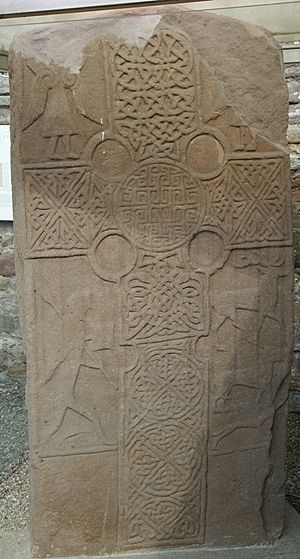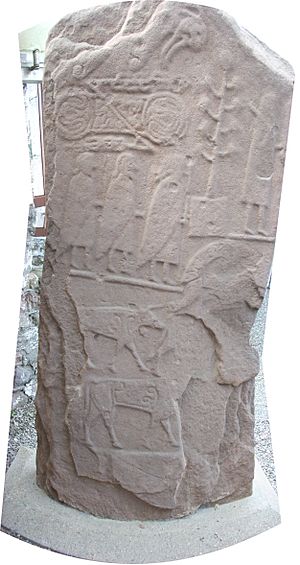Eassie Stone facts for kids
The Eassie Stone is a really old stone, carved by the Picts around the mid-700s AD. It's found in the small village of Eassie in Angus, Scotland. This special stone was discovered in a stream nearby in the late 1700s. Today, you can see it safely kept in a clear, custom-built shelter inside the old, ruined Eassie church.
Contents
Where to Find the Eassie Stone
The Eassie Stone is kept in a special see-through building. This building is inside the old Eassie church, which doesn't have a roof anymore. You can find it on the north side of the A94 road. It's about 4 kilometers (2.5 miles) west of Glamis and 6 kilometers (3.7 miles) east of Meigle.
What Does the Eassie Stone Look Like?
The Eassie Stone is a tall, flat stone, like a slab. It stands about 2.04 meters (6 feet 8 inches) high and is about 1.02 meters (3 feet 4 inches) wide at the bottom. It gets a bit narrower at the top. The stone is about 23 centimeters (9 inches) thick. Both sides of the stone are carved with raised designs, which is called "relief" carving. Because it has both a Christian cross and older Pictish symbols, experts call it a Class II Pictish stone.
The Front Side: The Cross
The front of the stone shows a large cross. This cross has round rings in its corners. In the middle of the cross is a circular bump with a cool "keywork" pattern. The arms and main part of the cross are covered in many detailed, woven patterns. These are like Celtic knots.
In the top corners of the cross, there used to be two angels. Sadly, they are a bit damaged now, and the angel on the right is almost gone. You can see a similar four-winged angel on another stone nearby called the Glamis 2 stone.
In the bottom left corner, there's a warrior wearing a cloak. He has a small, square shield (called a "buckler") and a spear. In the bottom right corner, you can see a stag (a male deer) and hunting dogs.
The Back Side: Symbols and Figures
The back of the stone has a mix of people, animals, and mysterious Pictish symbols.
At the very top, there's a damaged carving of a Pictish beast. This is a strange animal that often appears on Pictish stones. Below it, you can see a double disc and Z-rod symbol.
Below these symbols, there are three figures wearing cloaks. To their right, there's a person standing in front of a potted tree. Some historians think this tree might have human heads hanging from its branches, but it's hard to tell for sure.
Further down, there are some very worn carvings of a horseshoe and another Pictish beast symbol. At the very bottom of the stone, you can see carvings of cattle, but these are also quite worn down by time and weather.
History of the Eassie Stone
The Eassie Stone was found in a stream called the Eassie Burn around 1786. It was discovered by a person named Rev. Cordiner, near the Eassie Church. After it was found, the stone was moved to the churchyard. It stood there for over 100 years!
In the 1960s, a special building was made just for the stone. This building has clear walls so people can see the stone easily. It was built inside the old, ruined Eassie church. The church itself was likely built in the 1500s. It became a ruin after 1835 when a new, bigger church was built for the area.
The Eassie Stone and Other Pictish Art
The Eassie Stone is part of a group of Pictish sculptures known as the "Aberlemno School." This means it shares similar styles and features with other stones found in the area. Other famous stones in this group include:
- Aberlemno 2 (also called the Kirkyard Stone)
- Aberlemno 3
- Menmuir 1
- Kirriemuir 1
- Monifieth 2
- Rossie Priory
- Glamis 1
- Glamis 2
These stones help us learn a lot about the art and beliefs of the ancient Picts!



